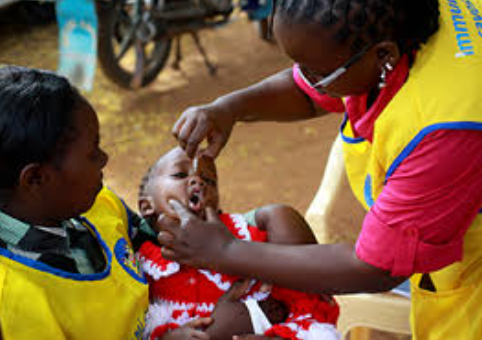Health officials have detected traces of the poliovirus in a sewage sample collected from Nairobi on May 15 this year. The sample tested positive for the circulating vaccine-derived poliovirus type 2 (cVDPV2) at the Kenya Medical Research Institute (KEMRI) laboratories.
According to the report Kenya filed with the Global Polio Eradication Initiative (GPEI), no associated cases of paralysis have been detected, and the risk to the general public in Nairobi is considered low.
The GPEI stated that the virus found in the sewage was likely excreted by a person vaccinated with the oral polio vaccine (OPV). Over the past 12 months, Kenya has vaccinated millions of children using the OPV, which contains a live but weakened virus.
The OPV is more effective than the injectable vaccine—used in most developed countries—that contains killed viruses, as it stimulates long-lasting immune responses in the intestines where polio replicates. However, these weakened viruses can sometimes be excreted live and become active again.
The GPEI explained that the vaccine virus is excreted in the stool, and in communities with poor sanitation, it can be spread from person to person. In extremely rare cases, people infected with the excreted virus can develop paralysis if they were not vaccinated beforehand.
This is the second case of vaccine-derived poliovirus reported in Kenya this year. A stool sample collected on February 21 also tested positive for polio. All samples are tested at KEMRI laboratories, which are accredited by the GPEI.
Kenya is among the countries that monitor sewage to predict potential polio outbreaks. Polio is highly infectious and primarily affects children under five, causing permanent paralysis in approximately one in every 200 infections. Although it has no cure, it can be prevented and eradicated through vaccination.
Eradicating polio requires 100 percent vaccine coverage, but the World Health Organization (WHO) estimates the vaccination rate in Kenya is about 91 percent. In some areas, particularly near Somalia, the vaccination rates are as low as 77 percent.
The Ministry of Health has not announced any actions regarding the two reported cases this year. Last year, Kenya confirmed eight cases of vaccine-derived poliovirus (cVDPV2).
Genetic sequencing indicated that the isolated cVDPV2 was linked to the strain circulating in Banadir, Somalia, according to the Global Polio Eradication Initiative (GPEI) last year. In response to these eight cases, the Ministry of Health conducted three rounds of vaccination.
In the first round, conducted between August 24 and 28, 1.9 million children were vaccinated in Kiambu, Kajiado, Garissa, and Nairobi counties. The second round took place in October in Mandera, Wajir, Tana River, Lamu, Kitui, Machakos, Kiambu, Kajiado, Nairobi, and Garissa, reaching 3,119,158 children.
The third round was conducted in January 2024 in Mandera, Wajir, and Garissa, reaching 755,011 children under the age of five and an additional 238,447 children aged between five and 15 years in Fafi and Dadaab subcounties and all refugee camps in Garissa. This third drive was initially planned for November 2023 but was postponed due to heavy rains in North Eastern Kenya.
The current cases may pose a challenge due to a shortage of polio vaccines in the country.
“A crisis looms in Hagadera at Dadaab refugee camp, with only 60 doses of Oral Polio Vaccine remaining,” the International Rescue Committee Kenya country director Mohamed El Montassir Hussein said on June 1 this year.
Last month, Medical Services Principal Secretary Harry Kimtai said the shortage was a result of Sh3.6 billion debt owed to suppliers.
“Currently, there are stockouts of key vaccines, with less than two months of stock available nationally for traditional vaccines such as the BCG Vaccine, Oral Polio Vaccine, and Measles Rubella Vaccine,” he said in a statement.
Treasury later released Sh1 billion, after which the Ministry of Health procured childhood vaccines worth Sh1.25 billion.
“We are pleased to announce the receipt of the following vaccines:1,209,500 doses of Measles Rubella vaccines, 3,032,000 doses of Oral Polio Vaccines (bOPV), 1,000,000 doses of Tetanus-Diphtheria vaccines and 2,120,000 doses BCG vaccines,” Medical Services PS Harry Kimtai said last month.



